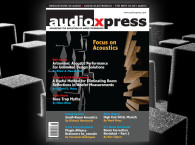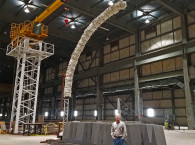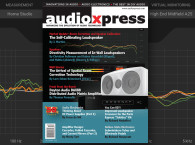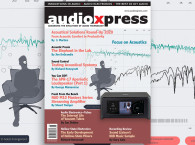 As audioXpress does every year, the August 2022 issue of audioXpress features an extensive Acoustical Solutions Round-Up highlighting companies and products that define market trends in acoustics. Each year, there are increasing numbers of acoustical products on the market helping to tackle the most demanding projects. This year’s Focus on Acoustics article, "Improving Acoustics in Home, Office, and Work Spaces," explores the growing segment of sound isolation booths, space dividers, and other approaches for workspaces that also tick the boxes of sustainability and creating attractive aesthetic options. And the round-up also includes new solutions in active and variable acoustics, a new approach that is becoming increasingly attractive for demanding applications.
As audioXpress does every year, the August 2022 issue of audioXpress features an extensive Acoustical Solutions Round-Up highlighting companies and products that define market trends in acoustics. Each year, there are increasing numbers of acoustical products on the market helping to tackle the most demanding projects. This year’s Focus on Acoustics article, "Improving Acoustics in Home, Office, and Work Spaces," explores the growing segment of sound isolation booths, space dividers, and other approaches for workspaces that also tick the boxes of sustainability and creating attractive aesthetic options. And the round-up also includes new solutions in active and variable acoustics, a new approach that is becoming increasingly attractive for demanding applications.
Extending the topic, Norman Varney shares his R&D Stories about "Acoustic Diffusion Research," a valuable inside perspective about developing new diffuser solutions, and lessons learned while designing countless critical listening rooms around the world. Norman Varney was actively involved in multiple acoustics standards committees, including for testing procedures, and he explains why diffusers continue to be misunderstood and many times wrongly used. He also details a journey that lead to the creation of the unique PolyFlex diffuser, which will scatter either horizontally or vertically, depending on the orientation, and improve clarity in speech and spatial focus without making a room sound dead and/or small.
In his regular Sound Control column sharing essential knowledge about acoustics, Richard Honeycutt writes about "Reverberation: Control and Measurement." From ancient amphitheaters to Wallace Sabine’s equation and the latest methods of measuring RT, this article explores the attempts to understand, explore, and control reverberation in rooms.
And next up, Thomas Perazella shares how he decided to use Distributed Subwoofers to handle room modes in his recently built listening room. In his DIY account of the project, Perazella builds and places multiple subwoofers at different locations in the room to create a greater distribution of modes. This is the same room where the author listens to his famous Egg Speakers, and he also wrote about it in his acoustic treatment project in the August 2021.
And diving into audio electronics and DIY, the August 2022 issue of audioXpress includes a great project from microphone and recording specialist Michel Nieuwenhuizen. This time he explains the possible ways to improve microphone preamplifiers circuits powering condenser microphones, and the different circuit options to decouple the microphone input from the preamplifier itself. The author proposes a high-quality design with a DC-coupled input with floating supply. With this preamplifier, he built a complete rack system that he used to record organ music, connecting the microphones he described in the October/November 2020 issues of audioXpress.

A second preamplifier project in this issue is used to solve a different type of problem. Author Aren van Waarde builds a Minimalist Line-Level Preamplifier with Discrete Transistors, using a layout proposed by Nelson Pass in order to play music via an existing commercial power amplifier. Using the available time from pandemic lockdowns, he constructed a preamp using only discrete transistors and other parts he had on hand. The preamp consists of a gain stage (left and right channel, discrete op-amp with six BJTs per channel as proposed by Nelson Pass in his article “DIY Op Amps”), the ±30V power supply made with 12 discrete transistors (a modified circuit of the now defunct Norwegian company Tandberg), and a small PCB-type power transformer. The results surprised positively.
And finally and to close the edition in the best way possible, Ethan Winer offers his fifth article on "Building a Guitar-Controlled Synthesizer," where he describes how to make two key modules needed by every analog synthesizer: the Voltage Controlled Amplifier (VCA) and Voltage Controlled Filter (VFC). For the past four issues he has shared the modules he used for his project that uses an electric guitar instead of a keyboard to control an analog synthesizer. The control voltages that set the volume and filter frequency come mainly from the ADSR envelope generator shown in the June, 2022 issue of audioXpress. But the low frequency oscillator (LFO) from that same issue is also used to provide a tremolo effect when driving the VCA, or to sweep the filter cyclically to add animation. This article explains two different VCA circuits, with a simpler one that works fine for one-off projects where precise unit-to-unit repeatability isn’t needed, and a second circuit similar to the VCA in the original Moog synthesizers, using a topology similar to the Moog VCF.
Another very strong issue of audioXpress with valuable articles and the best in DIY. A lot to explore now and many times later. Remember, every month, audioXpress brings innovations in audio, different topics in audio electronics, and the best in DIY audio, published 12 times per year, and available in print and online.

Subscribing to the digital online version allows immediate access and is available here: www.audioxpress.com/page/audioXpress-Subscription-Services.html
If you wish to buy a single printed issue or the complete audioXpress archive on USB, from 2000 to 2021 (yes, including the latest issue), just visit our online shop at www.cc-webshop.com
Don't miss out, get your copy of audioXpress right now at www.gotomyxpress.com







